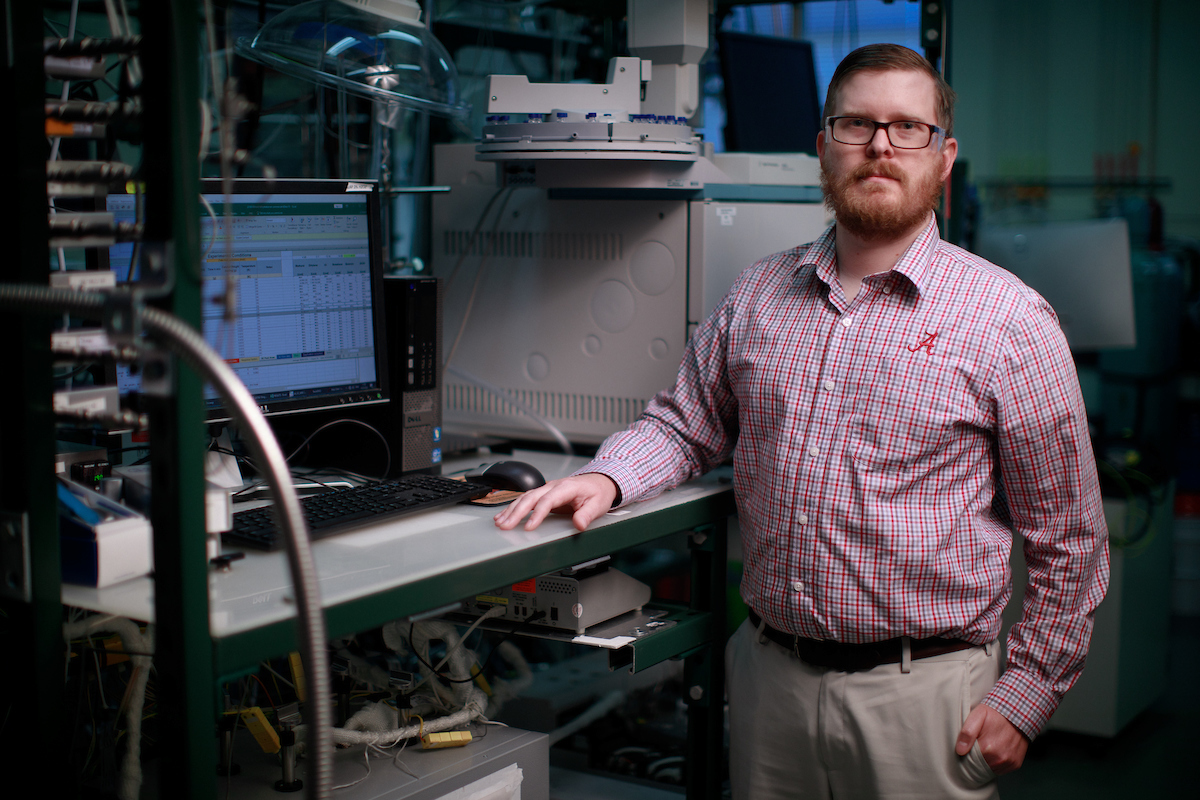
TUSCALOOSA, Ala. – Engineering researchers at The University of Alabama are spearheading a project to demonstrate an innovative method to create jet fuel from plants, helping the airline industry meet goals for using a renewable fuel source and reducing greenhouse gas emissions.
Supported by $2.5 million from the United States Department of Energy, the effort hopes to advance a catalyst containing three different metals used to chemically convert ethanol into butene that can be further modified to produce the same aviation fuel that currently originates from crude oil. Sustainable aviation fuel, or SAF, would counteract a plane’s emissions of harmful carbon dioxide, or CO2, through the CO2-consuming plants needed to make the fuel.
“In order to minimize greenhouse gas emissions from the aviation industry, the carbon footprint of the fuel has to be minimized,” said Dr. James Harris, UA assistant professor of chemical and biological engineering and project lead. “For sustainable aviation fuel to scale up from limited use it needs to be processed much more energy and cost efficiently, and our project is a key step towards producing jet fuel from renewable sources.”
The nation’s commercial aviation industry currently contributes 2% of the nation’s greenhouse gas emissions, according to the U.S. Department of Energy.
SAF has the potential to deliver the same performance as petroleum-based jet fuel, but with a fraction of its carbon footprint. SAF can be made from renewable biomass and other resources such as corn grain, algae, agricultural and forestry residues, and municipal solid waste streams. The federal government estimates enough biomass can be collected sustainably each year in the U.S. to produce 50-60 billion gallons of low-carbon fuels.

Planes require SAF to be the same chemical formulation as the fuel made from refined petroleum because of the extreme requirements of operating planes at different altitudes and temperatures along with the energy needed to take off. Also, it would be prohibitively expensive and difficult to modify existing planes and future aircraft design and manufacturing to accommodate fuels distinct from existing petroleum-based jet fuel.
Except in niche circumstances such as small planes for short trips, electrically powered planes would be too heavy because of the battery and energy needs at take-off.
“Since a hydrocarbon-based fuel is needed, it should ideally be a carbon-neutral fuel,” Harris said.
To reach the goal of powering planes with SAF, the process to get from biomass to the end fuel must improve so industry can produce it on a large scale at the same cost as current fuel.
Harris’ lab is studying a catalyst that processes ethanol. The catalyst is a fine powder containing various metals that can be formed into pellets over which the ethanol flows and is chemically converted to butene. Currently, two separate chemical reactors are needed, but the catalyst used in this project only requires one. It’s a cheaper process with fewer emissions that uses less energy, reducing the carbon footprint.
However, catalysts, including this one, often lose potency over time, halting the fuel refining while the catalyst is regenerated for further use. Harris and his lab will examine, characterize and test different formulations of the catalyst to increase its efficiency to at least 2,000 hours, reducing time spent regenerating the catalyst.
Dr. Daqian Jiang, assistant professor of civil, construction and environmental engineering, will analyze the carbon footprint of the process across the life cycle of the fuel and compare this to the carbon footprint of existing, petroleum-derived aviation fuel.
Johns Hopkins University is also a partner on the project along with Oak Ridge National Laboratory, where the catalyst was first formulated. The industrial catalyst manufacturer Clariant will provide the pelleted catalyst so testing and experimentation is done with the same material that would be used in the industry.
“This grant will fund graduate students and post-doctoral researchers while also allowing undergraduate students to work on an industrially relevant project alongside experts from Oak Ridge National Lab,” Harris said.
Contact
Adam Jones, UA communications, 205-348-4328, adam.jones@ua.edu
